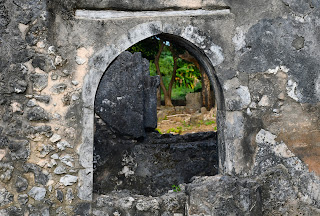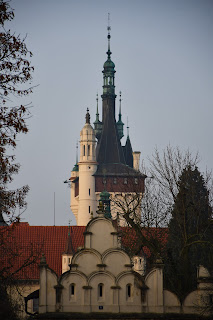Kilwa Day 2: A tour of Songo Mnara and Kilwa Kisiwani
Dating to the 9th century CE, Kilwa Kisiwani is one of the most historically significant settlements in East Africa. It flourished between the 13th and 15th centuries as the seat of the Kilwa Sultanate, a political entity that controlled much of the Swahili Coast and with it, much of the trade that went on between Africa and other civilisations across the Indian Ocean: The Arabian Peninsula, India, and even China. Ibn Battuta, who visited the island city in 1331, described it as one of the most beautiful in the world. It was destroyed by the Portuguese in 1505, who built a fort and stayed until they, in turn, were forced out by the Omanis.
Just south
of Kilwa Island lies the island of Songo Mnara. This is one of several historic
settlements that dot the coasts around Kilwa Kisiwani, but it has some of the best-preserved
buildings in the whole area. The Tanzanian tourism authority, which requires
that people only visit the sites with licensed guides, allows visits to both
Kilwa and Songo Mnara, both of which have well-kept trails and are more fully
excavated than other sites.
I had
reserved a tour of Kilwa Kisiwani and Songo Mnara in advance, but I suspect my
reservation might have been forgotten until the evening I showed up and asked
when we would be leaving. For one, the manager seemed sceptical I had booked a
tour until he looked it up in the system. Secondly, the tour started with a
half an hour delay because fuel had to be procured for the boat. Once the fuel
had been poured into the engine, the young assistant to the tour guide spent
the first hour of the journey bailing water from underneath the floorboards
with the bottom half of a former oil canister.
We began
our tour in Songo Mnara, which lies about an hour and a half away from the
mainland. To get there, we sailed between Kilwa Kisiwani and the mainland, with
the captain explaining that the shorter route on the open sea was a bit too
choppy. This allowed me to catch my first few glimpses of the historic sites on
Kilwa: the palace, Malindi Mosque, and the Portuguese Fort. I believed the
guide about the choppy waves when we reached the gap between the two islands
and there was nothing to shield us from the eastern winds. Our boat swayed left
and right, spraying us all with ocean water as it crashed down from the waves.
The main
port of Songo Mnara is a cove by a small fishing village in the middle of the
mangroves. One smells it before entering: standing outside the houses are
wooden racks for drying fish, and various other unidentifiable smells join in
on this omnipresent fragrance. The village, my guide Othman explained, is but a
temporary one, which is evident from the light wood and palm fronds from which
it has been built. Even the local mosque is evidently not made to last, nor is
the local cinema with its incongruously modern satellite dish. In exchange for
letting them reside on the island and ply their trade in its waters, the
fishermen pay a fee to its permanent residents, who live in houses made of
stone and old coral taken from the historic site.
Following
the path from the village through a coconut grove, we arrived at a fork in the
road. To our left, the path continued unchanged but in a slightly different
direction. To our right, it made its way through the flooded mangrove trees.
Naturally, I assumed we would be taking the first, but this naïve preconception
shattered when Othman started taking off his trousers. “At high tide,” he said
and gestured in front of his chest with his palm facing downward, “the water
reaches all the way up here.” I was relieved to find that I had put on untorn
underwear as I followed Othman’s lead.
Approaching
the mangroves, our feet set the mudskippers jumping onto the tree roots, and
tiny fish darted away from us as we waded in. Mangrove forests act as nurseries
to baby fish, which avoid predators by hiding among their roots – in some cases
waiting to become formidable predators themselves, like the small barracuda
Othman pointed out. Clearly passionate about nature, Othman also showed me the
differences between the mangroves. Just on this short walk, we saw at least
three species: the grey mangrove, the black mangrove, and the red mangrove. The
last of these reproduces with long, heavy seeds, which fall from the trees and
stick in the ground like spears, or else fall into the sea and slowly turn into
a vertical position as they absorb water.
Songo Mnara
lay just behind this flooded forest. I first saw several tall baobab trees
before I noticed that they were growing from among the ruins of the old
buildings. We followed the outer wall to the first and only remaining floor of
a tower that once defended the settlement. The whole site used to be higher
above sea level, but it has since sunk, and a causeway has been built to allow visitors
passage. From the former tower, we continued to the cemetery, which lies within
the city walls, after which we looped back to the main complex of Songo Mnara.
At the
heart of the complex stands the palace – a building with a quadrilateral
theatre pit and some indications of an erewhile second storey as well as a few
original ceilings. Some parts of the complex have been reconstructed,
particularly the quaint niches and ornate doorways. Next to this complex are the
ancient office building and quarters for lodging guests: due to the regularity
of the monsoons, traders who came from the east had to stay on the island for
months on end before the winds reversed and they could set sail for home. These
guests could make use of the town’s many mosques, of which some have survived
in a surprisingly good state.
We returned
to the boat after perhaps an hour and a half. By the time we reached our
mangrove trail, the tide had risen even further, and I was dismayed to see
Othman taking off his shirt along with his trousers. Perhaps partly out of
denial, I refused to undress, and by the time I had reached the other side, my
shirt was wet up to my bellybutton.
We ate
lunch on the boat as we began our return journey to Kilwa Kisiwani. The clouds
came in but dispersed again by the time we made land on the beach by Makutani
Palace. As we walked along the beach, I noticed something white and blue in the
pebbles just a few paces ahead. I stooped down and to my great surprise, I
found it had Chinese writing on it – it was the fragment of a porcelain vase!
“Look at this!” I called to my guide.
“Yes,” he
said simply, “it is Chinese. There is a lot of pottery, some from China, some
from Arabia, some from India…”
I did not
think such a pretty find was so unremarkable. My hand started slipping down to
my pocket.
“You cannot
take anything from the beach,” Othman said sternly.
I did not
even know what I intended to do with the shard, but my mind rebelled against throwing
it back into the waves. “Maybe we can bring it to a museum?” I ventured
sheepishly.
“There is
no museum.”
The five
hundred years of history between me and the shard screamed in my head. If I put
it back, would anyone ever find it again? Would a chance crash against a rock destroy
it for good? I lay it down on a slightly elevated rock and took a few pictures
so that it might at least not be forgotten.
We walked
around the gutted insides of Makutani Palace, where we continued a previous
discussion on the functionality of the civilisation’s toilets. I could not wrap
my head around the fact that the toilets did not simply flow out into the sea
and were not emptied. Instead, the guide said, the walled waste holes under the
toilets were built without mortar, which allowed the waste to be absorbed into
the ground when flushed with seawater.
Makutani
Palace was built by the Omanis in the eighteenth century, its design reflecting
a newfound need to build advanced fortifications. Before the ill-omened arrival
of the Portuguese, the former palace – Husuni Kubwa – stood on a bluff
overlooking the sea and was more of a residence than a fortification. It was
easy for the Portuguese to raze it to the ground. In contrast, Makutani Palace
served partly as a fortress, with the Sultan’s lodgings and offices located on
the second floor. Like many defensive structures, it was built with arrow slits
that allowed friendly forces to shoot at their enemies without running an
excessively high risk of being shot themselves.
A short
walk away from Makutani Palace stands the fifteenth-century Small Domed Mosque,
which still retains most of its variously designed domes. To its right, the
path branches off towards the royal cemetery, going past a vast tidal
plain from which the sea can barely be seen for the distant mangrove trees.
Walking across the plain, I was afraid I might step on one of the many crabs
running before our feet with their colourful claws held out against their
chests like little matadors. Fortunately, they were all much faster and
cleverer than I thought.
The royal cemetery lay in the shadow of a giant baobab tree.
Othman explained that baobabs can live for thousands of years, and that many
reach this venerable age thanks to the fact that they are useless to humans.
Their wood is soft and brittle, unusable for making furniture, ships, or even charcoal.
On the other hand, a live baobab can often act as a water reservoir if it
happens to be hollow on the inside, and elephants like to chew on the tree’s succulent
bark.
Finally, we reached the most famous site on Kilwa Kisiwani,
the Great Mosque. Founded in the tenth century, the mosque was renovated and
rebuilt multiple times as the settlement grew in wealth and importance. Instead
of the familiar tower-like minaret, the mosque has a small platform by the
common entrance: my guide climbed it and pretended making a call to prayer to
the amusement of a few local passersby. After its modern rediscovery by
archaeologists, it had to be partially dug up from the ground, which is
evidenced by the roots of the trees growing out of its walls, which extend
abruptly downward from what was once ground level for them.
We finished our walk by the Portuguese Fort (the Gereza) we
had seen from the sea. It stands opposite the small Malindi Mosque, which,
unusually, has a row of pillars right in front of its mihrab, splitting the
hall into two halves rather than creating a nave or a large hall. In the
neighbourhood of this mosque lies another cemetery, this one built for affluent
merchants. Othman explained that although the town made plenty of money by
trading slaves and ivory, its real wealth lay in gold: Kilwa was once the
terminus of a land route leading all the way to the goldmines of the once
glorious kingdom of Great Zimbabwe. After the arrival of the Europeans, this
trade route got rerouted to the Portuguese colony of Mozambique, robbing Kilwa
of its importance and accelerating its decline from which it never recovered.









































Comments
Post a Comment